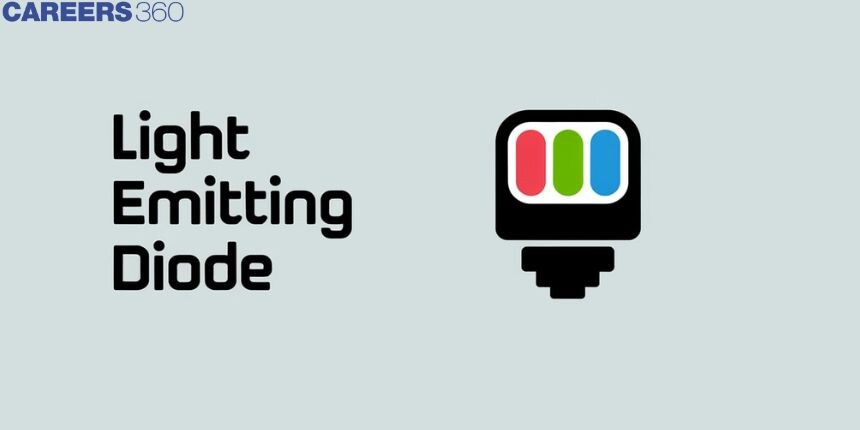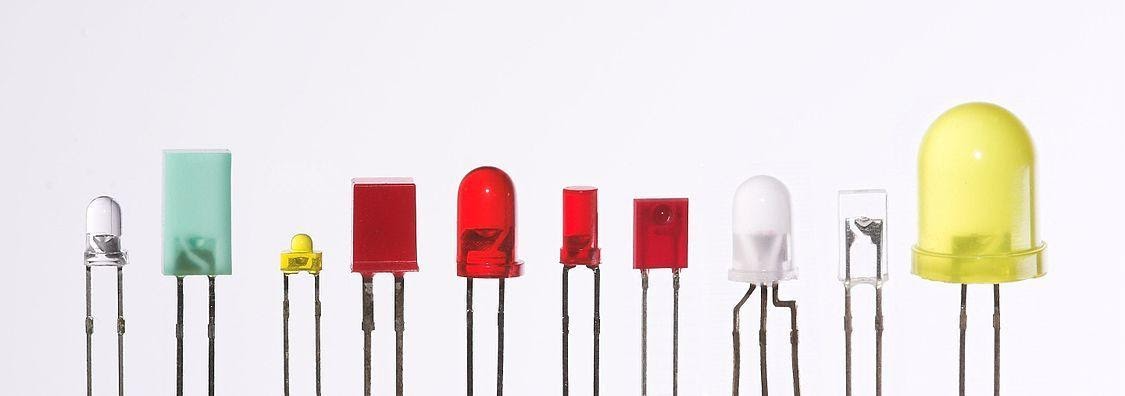Light Emitting Diode - Meaning, Principle, Uses, Types, FAQs
A light-emitting diode is a device that emits light in the presence of an electrical current. Thanks to their energy efficiency and extended service life, LEDs have altered the way people light their homes and other structures and even the streets. In practice, they are present within the displays of smartphones and even in traffic light systems showing their significance in the present-day technology.

What is LED?
LED stands for Light Emitting Diode and it is a device which emits light by flowing a current to the positive-negative junction like a semiconductor laser. It emits various wavelength lights in the ultraviolet, visible and infrared regions, corresponding to its band gap energy.

LED symbol and LED diagram (LED circuit diagram)
In circumstances where traditional circuits, such as a standard diode are employed, the LED also have a specified voltage drop forward. The voltage drop is determined by the LED's current, the colour of the light generated and other factors. The voltage drop varies between 1.5V and 2.5V for currents ranging from 10 to 50 mA.
Principal of LED
The LED is connected in the forward bias, which allows the current to flow in the forward direction. The flow of current is caused by the movement of electrons in the opposite direction. The recombination shows that the electrons move from the conduction band to the valence band and they emit electromagnetic energy in the form of photons. The energy of photons is equal to the gap between the valence and the conduction band. The energy is released in the form of heat in conventional LED diode workings. However, with an LED, the release of energy in the form of photons would result in the emission of light energy. The process is referred to as electroluminescence.
How much energy is discharged in the form of light in an LED is determined by the forbidden energy gap. As a result, the light colour and visibility cannot be altered based on its wavelength. By doping the light with various contaminants, the colour and wavelength of the light emitted may be determined.
|
Related Topics |
Working of LED
LED is nothing but a diode made of semiconductors having a $\mathrm{P}-\mathrm{N}$ junction. LED is based on the phenomenon of recombination of electrons with holes. When the LED is forward biased, the electrons from the N -region cross the P - N junction and recombine with the holes existing in the P -region. For the electrons to recombine with holes existing in the P-region, they must give some of their energy. When recombination occurs, the recombining electrons release energy in the form of heat and light.

What determines the colour of an LED?
The colour of an LED is determined by the material used in the semiconducting element. The two primary materials used in LEDs are aluminium gallium indium phosphide alloys and indium gallium nitride alloys. Aluminium alloys are used to obtain red, orange and yellow light, and indium alloys are used to get green, blue and white light. Slight changes in the composition of these alloys change the colour of the emitted light.
Uses of LED
LEDs are used in a variety of industries, such as optical communication, alarm and security systems, remote-controlled operations, robotics, and so on. Because of its long-lasting capability, low power needs, quick response time, and fast switching capabilities, it uses LED in a variety of applications. The following are some of the standards that LED adheres to:
- Backlighting for televisions
- Frequently seen in exhibits
- Applied to automobiles
- LEDs are utilised in light dimming.
What Determines an LED's Colour?
The colour of an LED is determined by the energy band gap of the semiconductor material used to make the LED. The energy band gap is the difference in energy between the valence band and the conduction band of a semiconductor material. LEDs made of different semiconductor materials with different energy band gaps will emit light of different colours.
For example, red LEDs are made of gallium arsenide (GaAs), which has a relatively small energy band gap. Blue LEDs are made of gallium nitride ( GaN ), which has a relatively large energy band gap. White LEDs are typically made of gallium indium nitride (GalnN), which has an energy band gap that can be tuned to emit different colours of light. White LEDs are also made using a combination of different coloured LEDs.
NCERT Physics Notes:
Types of LED
- Gallium Arsenide (GaAs) is an infrared semiconductor.
- Red to infrared, orange Gallium Arsenide Phosphide (GaAsP).
- High-brightness red, orange-red, orange, and yellow Aluminium Gallium Arsenide Phosphide (AlGaAsP).
- Gallium phosphate (GaP) comes in three colours: red, yellow, and green.
- Green Aluminium Gallium Phosphide (AlGaP).
- Green, emerald green gallium nitride (GaN).
- Near-ultraviolet gallium indium nitride (GaInN) — bluish-green and blue.
- As a substrate, Silicon Carbide (SiC) is blue.
- Blue Zinc Selenide (ZnSe).
- AlGaN (Aluminium Gallium Nitride) – ultraviolet.
LEDs have a wide range of shapes sizes and colours. The colour of the plastic lens is frequently, but not always, the same as the colour of the light emitted. Infrared LEDs, for example, are frequently made of purple plastic, whereas most blue gadgets have colourless housings.

Advantages and Disadvantages of LEDs
Advantages of LEDs
1. LEDs are small-sized and can be assembled to form numeric and alphabet displays.
2. LEDs are environmentally and economically friendly.
3. LEDs are rugged and can-, therefore, withstand shocks and vibrations.
4. LEDs can be operated in a wide range of temperatures.
5. The switching time of the LED (both on and off) is less than one. So, they are very suitable for the dynamic operation of many arrays.
Disadvantages of LEDs
1. The drawbacks of LEDs are that they get damaged by overvoltage or overcurrent.
2. They have wide optical bandwidth compared to LASER ( $=10 \mathrm{~nm}$ ).
3. Their temperature depends on the radiant output power and wavelength.
4. LEDs are not suited for large-area displays, primarily because of their high cost. For larger displays, devices using gas fillers are used.
Frequently Asked Questions (FAQs)
The rated life of many LED is up to 50,000 hours. This is roughly 50 times longer than an incandescent bulb, 20-25 times longer than a halogen bulb, and 8-10 times longer than a CFL bulb. A 50,000 bulb will survive more than 11 years if uses of LED 12 hours a day.
Principle of Operation: A light-emitting diode (LED) is a semiconductor light source with two leads. When triggered, it is a p–n junction diode that emits light. Electrons are able to recombine with electron holes within the device when a proper voltage is given to the leads, releasing energy in the form of photons.
Drawbacks of LED lighting are:
High setup costs.
Compatibility with transformers
Colour shift throughout lamp life is a possibility.
Standardization of performance has not yet been streamlined.
Overheating can shorten the life of a lamp.
A light bulb's electricity consumption is measured in KWh. Over the course of a 15,000-hour lifespan, an LED bulb consumes 127.5KWh. Incandescent bulbs that are uses of LED for 15,000 hours (theoretically; incandescent bulbs do not last that long) consume 900KWh of electricity.
LED (Light emitting LED diode workings) transform electrical energy directly into light, as opposed to traditional light sources that convert electrical energy into heat and subsequently into light, resulting in efficient light creation with minimal electricity waste.